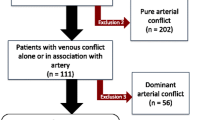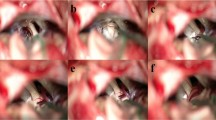Abstract
Background
Neurovascular conflict is considered a key element of classical trigeminal neuralgia (TN) and consequently, microvascular decompression (MVD) is an effective treatment. Nevertheless, failures of MVD are described by many authors. In some patients, the arachnoid membranes surrounding the trigeminal nerve and neighbouring vessels may be thickened and adhesive. Here we analyse the impact of such focal arachnoiditis on outcome after MVD for TN.
Methods
A cohort of prospectively followed patients after their MVD was reviewed for intraoperative, imaging and clinical data if findings of arachnoiditis during MVD were described. Long-term outcome assessment was the main endpoint.
Results
We reviewed data from 395 MVD procedures, performed for TN from 2001 to 2014. Intraoperative evidence of focal arachnoiditis, as described by the surgeon, has been noted in 51 patients (13%). In 35 (68.6%), neuralgia was typical and in the other 17 (31.4%) it was atypical.
As expected by definition, neurovascular conflict was found in 49 interventions (96%); it was predominantly arterial in 27 (52.9%). Accompanying arachnoiditis was encountered: mild in 20 interventions (39.2%), severe in 31 (60.8%).
A successful result (BNI I or II) was achieved in 29 patients (56.9%). The other 22 patients (43.1%) had persistence or recurrence of pain. Overall KM probability of being pain free at 15 years was 72%.
Conclusions
Intraoperative finding of arachnoiditis during MVD for classical trigeminal neuralgia is associated with poorer outcome than that of classical trigeminal neuralgia in general. This is particularly true for low grades of conflict.



Similar content being viewed by others
Change history
20 November 2019
Figure 3 corrected.
References
Barker FG, Jannetta PJ, Bissonette DJ, Larkins MV, Jho HD (1996) The long-term outcome of microvascular decompression for trigeminal neuralgia. N Engl J Med 334(17):1077–1083. https://doi.org/10.1056/NEJM199604253341701
Burchiel KJ (2016) Trigeminal neuralgia: new evidence for origins and surgical treatment. Neurosurgery 63(Suppl 1):52–55. https://doi.org/10.1227/NEU.0000000000001276
Cevizci R, Dilci A, Tekin AM, Bayazıt Y (2017) Recovery of tinnitus and sensorineural hearing loss due to lysis of arachnoid adhesions in the posterior cranial fossa: is there a novel etiology in neurotological disorders? J Int Adv Otol 13(2):295–297. https://doi.org/10.5152/iao.2017.3393
Cruccu G, Finnerup NB, Jensen TS, Scholz J, Sindou M, Svensson P et al (2016) Trigeminal neuralgia: new classification and diagnostic grading for practice and research. Neurology 87(2):220–228. https://doi.org/10.1212/WNL.0000000000002840
Dumot C, Brinzeu A, Berthiller J, Sindou M (2017) Trigeminal neuralgia due to venous neurovascular conflicts: outcome after microvascular decompression in a series of 55 consecutive patients. Acta Neurochir 159(2):237–249. https://doi.org/10.1007/s00701-016-2994-y
Gardner WJ (1953) The mechanism of tic douloureux. In: Transactions of the American Neurological Association, 3(78th meeting), pp 168–171 discussion, 171–173
Gardner WJ (1962) Concerning the mechanism of trigeminal neuralgia and hemifacial spasm. J Neurosurg 19:947–958. https://doi.org/10.3171/jns.1962.19.11.0947
Gudmundsson K, Rhoton AL Jr, Rushton JG (1971) Detailed anatomy of the intracranial portion of the trigeminal nerve. J Neurosurg 35(5):592–600
Hardaway FA, Holste K, Ozturk G, Pettersson D, Pollock JM, Burchiel KJ (2019) Raslan AM sex-dependent posterior fossa anatomical differences in trigeminal neuralgia patients with and without neurovascular compression: a volumetric MRI age- and sex-matched case-control study. J Neurosurg:1–8. https://doi.org/10.3171/2018.9.JNS181768 Epub ahead of print
Jannetta PJ (1967) Arterial compression of the trigeminal nerve at the pons in patients with trigeminal neuralgia. J Neurosurg 26(1), Suppl):159–162. https://doi.org/10.3171/jns.1967.26.1part2.0159
Killeen T, Kamat A, Walsh D, Parker A, Aliashkevich A (2012) Severe adhesive arachnoiditis resulting in progressive paraplegia following obstetric spinal anaesthesia: a case report and review. Anaesthesia 67(12):1386–1394. https://doi.org/10.1111/anae.12017
Ko AL, Ozpinar A, Lee A, Raslan AM, McCartney S, Burchiel KJ (2015) Long-term efficacy and safety of internal neurolysis for trigeminal neuralgia without neurovascular compression. J Neurosurg 122(5):1048–1057. https://doi.org/10.3171/2014.12.JNS14469 Epub 2015 Feb 13
Leal PRL, Hermier M, Froment JC, Souza MA, Cristino-Filho G, Sindou M (2010) Preoperative demonstration of the neurovascular compression characteristics with special emphasis on the degree of compression, using high-resolution magnetic resonance imaging: a prospective study, with comparison to surgical findings, in 100 consecutive patients who underwent microvascular decompression for trigeminal neuralgia. Acta Neurochir 152(5):817–825. https://doi.org/10.1007/s00701-009-0588-7
Leal PRL, Hermier M, Souza MA, Cristino-Filho G, Froment JC, Sindou M (2011) Visualization of vascular compression of the trigeminal nerve with high-resolution 3T MRI: a prospective study comparing preoperative imaging analysis to surgical findings in 40 consecutive patients who underwent microvascular decompression for trigeminal neuralgia. Neurosurgery 69(1):15–25; discussion 26. https://doi.org/10.1227/NEU.0b013e318212bafa
Maarbjerg S, Di Stefano G, Bendtsen L, Cruccu G (2017) Trigeminal neuralgia - diagnosis and treatment. Cephalalgia: Int J Headache 37(7):648–657. https://doi.org/10.1177/0333102416687280
Maarbjerg S, Sørensen MT, Gozalov A, Bendtsen L, Olesen J (2015) Field-testing of the ICHD-3 beta diagnostic criteria for classical trigeminal neuralgia. Cephalalgia: Int J Headache 35(4):291–300. https://doi.org/10.1177/0333102414542291
Maarbjerg S, Wolfram F, Gozalov A, Olesen J, Bendtsen L (2015) Significance of neurovascular contact in classical trigeminal neuralgia. Brain J Neurol 138(Pt 2:311–319. https://doi.org/10.1093/brain/awu349
Miller JP, Magill ST, Acar F, Burchiel KJ (2009) Predictors of long-term success after microvascular decompression for trigeminal neuralgia. J Neurosurg 110(4):620–626. https://doi.org/10.3171/2008.9.17660
Rongxun Z (1982) Chronic arachnoiditis in the posterior fossa: a study of 82 cases. J Neurol Neurosurg Psychiatry 45(7):598–602. https://doi.org/10.1136/jnnp.45.7.598
Sindou M, Howeidy T, Acevedo G (2002a) Anatomical observations during microvascular decompression for idiopathic trigeminal neuralgia (with correlations between topography of pain and site of the neurovascular conflict). Prospective study in a series of 579 patients. Acta Neurochir 144(1):1–12; discussion 12-13. https://doi.org/10.1007/s007010200000
Sindou M, Leston J, Decullier E, Chapuis F (2007) Microvascular decompression for primary trigeminal neuralgia: long-term effectiveness and prognostic factors in a series of 362 consecutive patients with clear-cut neurovascular conflicts who underwent pure decompression. J Neurosurg 107(6):1144–1153. https://doi.org/10.3171/JNS-07/12/1144
Sindou M, Leston J, Howeidy T, Decullier E, Chapuis F (2006) Micro-vascular decompression for primary trigeminal neuralgia (typical or atypical). Long-term effectiveness on pain; prospective study with survival analysis in a consecutive series of 362 patients. Acta Neurochir 148(12):1235–1245; discussion 1245. https://doi.org/10.1007/s00701-006-0809-2
Sindou M, Leston JM, Decullier E, Chapuis F (2008) Microvascular decompression for trigeminal neuralgia: the importance of a noncompressive technique—Kaplan-Meier analysis in a consecutive series of 330 patients. Neurosurgery 63(4 Suppl 2):341–350; discussion 350-351. https://doi.org/10.1227/01.NEU.0000327022.79171.D6
Xia L, Zhong J, Zhu J, Wang Y-N, Dou N-N, Liu M-X et al (2014) Effectiveness and safety of microvascular decompression surgery for treatment of trigeminal neuralgia: a systematic review. J Craniofac Surg 25(4):1413–1417. https://doi.org/10.1097/SCS.0000000000000984
Zakrzewska JM, Coakham HB (2012) Microvascular decompression for trigeminal neuralgia: update. Curr Opin Neurol 25(3):296–301. https://doi.org/10.1097/WCO.0b013e328352c465
Zakrzewska JM, Lopez BC, Kim SE, Coakham HB (2005) Patient reports of satisfaction after microvascular decompression and partial sensory rhizotomy for trigeminal neuralgia. Neurosurgery 56(6):1304–1311 discussion 1311-1312
Author information
Authors and Affiliations
Corresponding author
Ethics declarations
Conflict of interest
The authors declare that they have no conflict of interest.
Ethical approval
This study was approved by the ethics committee of the “Hopital Neurologique de Lyon”.
Informed consent
All patients signed an informed consent form with the surgeon prior to the procedure.
Additional information
Publisher’s note
Springer Nature remains neutral with regard to jurisdictional claims in published maps and institutional affiliations.
This article is part of the Topical Collection on Functional Neurosurgery - Pain
Rights and permissions
About this article
Cite this article
Mazzucchi, E., Brinzeu, A. & Sindou, M. Arachnoiditis as an outcome factor for microvascular decompression in classical trigeminal neuralgia. Acta Neurochir 161, 1589–1598 (2019). https://doi.org/10.1007/s00701-019-03981-7
Received:
Accepted:
Published:
Issue Date:
DOI: https://doi.org/10.1007/s00701-019-03981-7




